
Int.J.Curr.Microbiol.App.Sci (2017) 6(3): 40-56
40
Original Research Article https://doi.org/10.20546/ijcmas.2017.603.004
Vulnerability Assessment of Soil Erosion/Deposition in a Himalayan
Watershed using a Remote Sensing and GIS Based Sediment Yield Model
S.S. Rawat1*, M.K. Jain2, K.S. Rawat3, B. Nikam4 and S.K. Mishra5
1National Institute of Hydrology, Roorkee-247 667, Uttarakhand, India
2Department of Hydrology, Indian Institute of Technology-Roorkee, Roorkee-247 667,
Uttarakhand, India
3Center for Remote Sensing and Geo-Informatics, Sathyabhama University,
Chennai-600 119, India
4Indian Institute of Remote Sensing, ISRO, Dehradun-248 001, Uttarakahnd, India
5Department of Water Resources Development and Management, Indian Institute of
Technology-Roorkee, Roorkee-247 667, Uttarakhand, India
*Corresponding author
A B S T R A C T
Introduction
Soil erosion is a serious problem in
Himalayas and foothill ecosystem. Eighty
percent of the sediment material delivered to
the world’s oceans each year comes from
Asian rivers, and amongst these, Himalayan
rivers are the major contributors (Stoddart,
1969). The Himalayan and Tibetan regions
cover only about 5% of the earth’s land
International Journal of Current Microbiology and Applied Sciences
ISSN: 2319-7706 Volume 6 Number 3 (2017) pp. 40-56
Journal homepage: http://www.ijcmas.com
Soil erosion strongly affects crop yield, undermines the long term productivity of farm
land and sustainability of farming system, and poses a major threat to the livelihood of the
farmers and rural communities. The United Nations Environmental Program reported that
the productivity of soil has reduced and resulting in economically unfeasible cultivation on
about 20 million hectare of land each year due to soil erosion and resulting degradation of
land. The eroded soil is also a major cause of loss of storage capacity (1 to 2% annual
reduction globally) of multipurpose reservoirs due to sedimentation which affects society
at large. In developing countries like India, limited data availability constrains the
application of the sophisticated models in proper planning of erosion control measures. In
the present study, a simple spatially distributed model has been formulated in GIS
environment for mapping areas vulnerable to soil erosion and deposition in a Himalayan
watershed from India. The model discretizes the spatial domain of catchment into
homogenous grids/cells to capture the catchment heterogeneity and derived net erosion and
deposition maps by considering gross soil erosion and transport capacity of each cell.
Spatial distribution capability of the model has been checked at outlet as well as three
upstream gauging sites using eight years historical sediment yield data. The model
estimated the seasonal sediment yield with less than ±30% errors. Finally, entire watershed
has been classified into six different severity scales of erosion i.e. slight, moderate, high,
very high, severe and very sever. Such maps have immense significance to prioritize area
specific watershed conservation and management measures.
K e y w o r d s
GIS, RS, Soil
erosion, Sediment
yield, USLE,
Transport capacity.
Accepted:
08 February 2017
Available Online:
10 March 2017
Article Info

Int.J.Curr.Microbiol.App.Sci (2017) 6(3): 40-56
41
surface but supply about 25% of the dissolved
load to the world ocean (Raymo and
Ruddiman, 1992). Although, Himalayan
region is hydrologically very important as it is
the origin of three world’s major river system
viz. the Indus, the Ganges, and the
Brahmaputra but very few studies have been
reported on rainfall, runoff and its induced
sediment yield processes in this region. In
Himalayan or mountainous regions, the data
whether on economic, social, or
environmental are usually incomplete, when
they exist at all. Therefore, lack of scientific
knowledge about this planet’s most complex
landscape is main hurdle to plan the
developmental agenda for this region.
Soil erosion involves the processes of
detachment, transportation, and accumulation
of soil from land surface due to either impact
of raindrop, and shearing force of flowing
water. Based on the processes considered, as
well as the complexity, accuracy, scale (space
and time), and ultimately data requirement, a
wide range of models from simple empirical
to complex physically based have been
developed to model the soil erosion and
subsequent sediment yield (Merritt et al.,
2003; Aksoy and Kavvas, 2005). Simple and
popular empirical models such as USLE and
its derivatives perform very well at the plot
scale (Risse et al., 1993; Angima et al., 2003).
However, their use at catchment scale could
be challenging. Therefore various physically
based models such as Water Erosion
Prediction Project (WEPP) (Nearing et al.,
1989), Areal Non-point Source Watershed
Environment Response Simulation
(ANSWERS) (Beasley et al., 1980),
Agricultural Nonpoint Source Pollution
Model (AGNPS) (Young et al., 1989), Soil
and Water Assessment Tool (SWAT) (Arnold
et al., 1993), and many others have been
developed and these have proved very useful
as research tools. However, the use of
physically based models is mostly limited to
research due to their complexity and non-
availability of data required for field use. For
example, WEPP model requires as many as
50 input parameters, which can cause the
problem of equifinality (condition in which
different combination of model parameters
lead to similar output) (Brazier et al., 2000).
Therefore, empirical models are most
commonly used in field applications.
However, these are based on inductive logic
and generally applicable only to those
conditions for which the parameters have
been calibrated. Moreover, there is not a
single model valid for all applications.
Sediment outflow from a watershed depends
on several parameters which are responsible
for the soil detachment and the transport
capacity of the path followed by the eroded
soil to reach the outlet. However, lack of
detailed data with respect to these parameters
at river catchment scale is a major constraint
in estimation of sediment yield at catchment
scale (Van Rompaey et al., 2001). Therefore,
a simple empirical lumped sediment delivery
ratio (SDR) approach is used to link the soil
erosion within a watershed to the sediment
yield at outlet (Ferro and Minacapilli, 1995).
Since, SDR-based sediment yield estimation
approach is an empirical lumped approach
(Verstraeten and Poesen, 2001), it performs
well only if the data of catchment belongs to
inherent region. Applications of such
empirical approach to other catchments are
questionable and require rigorous calibration
before extension. Also due to lumped nature
of SDR approach, it is not helpful in
prioritization of watershed
management/treatment activities within a
river basin/catchment. However, soil erosion
and sediment yield exhibit large spatial
variability due to heterogeneity involved in
various parameters (catchment physical as
well as climatic) responsible for theirs
occurrence. The technique of Geographical
Information System (GIS) is well suited for

Int.J.Curr.Microbiol.App.Sci (2017) 6(3): 40-56
42
quantification of heterogeneity (not only in
space but also in time) in the topographic,
cover type, and drainage features of a
watershed by partitioning the watershed into
small homogenous grids (Jain et al., 2005;
Wu et al., 2005; Naik et al., 2009).
Furthermore, accessibility of data even in
remote areas like Himalayan catchment is the
major advantage of GIS and remote sensing
(RS) techniques.
Keeping in view, limited data availability in
Himalayan catchment and spatial variability
and complexity involved in soil erosion and
sediment production process, a simple
spatially distributed model has been
formulated in GIS environment. The model
produces outputs showing spatial variability
due to spatial discretization adopted and,
therefore, helpful in mapping of sediment
source and sink areas and prioritization of
watershed management activities accordingly.
However, model structure is kept simple so
that the application of model can be easily
extended in developing countries like India
where availability of data in space and time is
always a challenge.
Model formulations
The proposed model comprises of three major
components (1) the assessment of seasonal
gross soil erosion (GSE) for each grid/cell; (2)
the assessment of seasonal local transport
capacity (TC) for each grid/cell; and (3)
transport limited accumulation algorithm for
routing sediment from each of the discretized
grid/cell to the outlet of the catchment by
taking into account the local transport
capacity of each cell.
Estimation of gross soil erosion
Universal Soil Loss Equation (USLE) has
been found to produce realistic estimates of
surface erosion over small size areas
(Wischmeier and Smith, 1978; Jain and
Kothyari, 2000; Jain and Goel, 2002; Lee,
2004; Jain and Das, 2010). Although USLE is
a lumped empirical model, this equation has
been a part of several spatially distributed
process-based models such as SWAT,
AGNPS, CREAMS (Knisel, 1980), SEDNET
(Prosser et al., 2001) and EPIC (Williams,
1983). This is possible due to the
discretization of heterogeneous catchment
into small homogeneous grids/cells. In this
paper USLE is used for estimation of GSE
within a cell is expressed as:
iiiii PCLSRKGSE
(1)
Where, GSEi = gross amount of soil erosion
in cell i (MT ha−1 year−1); R = rainfall
erosivity factor (MJ mm ha−1 h−1 year−1); Ki =
soil erodibility factor in cell i (MT ha h ha−1
MJ−1 mm−1); LSi = slope steepness and length
factor for cell i (dimensionless); Ci = cover
management factor (dimensionless) and Pi =
supporting practice factor for cell i
(dimensionless).
Assessment of seasonal sediment transport
capacity
Sediment transport capacity expresses the
erosive power of overland flow or channel
flow which is responsible for the movement
of eroded soil. In fact, the process of soil
erosion and deposition is governed by the
sediment transport capacity of overland flow
and subsequent channel flow. Therefore,
sediment transport capacity equation is an
essential part of all physically based sediment
yield computation models. Several simple to
complex equations have been developed for
estimation of transport capacity of different
grid/cell within the catchment. One of the
most commonly used transport capacity
equation as given by Van Rompaey et al.,
(2001) is as follows:
IRTC aS-LSRKKTC
(2)

Int.J.Curr.Microbiol.App.Sci (2017) 6(3): 40-56
43
Where, TC is the transport capacity (kg m-2
year-1); KTC is the transport capacity
coefficient and SIR is the inter-rill slope
gradient factor. Van Rompaey et al., (2005)
reported poor performance (R=0.25) while
using this equation in mountainous part of an
Italian catchment. Normally, the topography
of hilly areas is such that flow converges at
some locations, generally at the junction of
the steep slope and valley floor (or toe of the
slope). These locations are generally the end
points of the steep slopes or where sudden
flattening in the slopes is observed. As per
equation 2 model estimates low values of
transport capacity of theses points due to low
values of slopes (S). Hence, most of the
eroded sediment will be deposited at theses
points and model underestimates sediment
outflow. However, in reality these are intense
flow convergent points and hence attributed
to high transport capacity. To overcome this
problem Verstraeten (2007) suggested to
incorporate an upslope contributing area
factor in transport capacity equation. After
incorporating an upslope contributing area
factor Equation 2 can be re-written as follows:
γ
si
β
iiTCiASRKKTC
(3)
Where, Asi is the upslope contributing area for
cell i which represents the actual flow
accumulation value of any cell. Incorporation
of upslope contributing area factor in
transport capacity equation (Equation 3),
transport capacity of intense flow convergent
areas will be increased significantly even
sudden fallen in slope (S).
Sediment routing using transport limited
accumulation
Eroded sediment from each cell follows a
definite path defined by direction of flowing
water. The amount of sediment outflow from
one cell to its downstream cell depends on
local sediment transport capacity (TC) for a
cell. If the local TC is smaller than the
sediment flux, then sediment deposition is
modeled. If TC is higher than the sediment
flux, then sediment transport will be supply
limited. Thus, by introducing the transport
capacity, a more realistic representation of
overland flow in sediment transport can be
simulated. The model produces different
maps of erosion, sediment transport, and
sediment deposition rates. For cell-based
discretization system, transport limited
accumulation can be computed as:
)TC,Tmin(GSET iiniout i
i
(4)
ii outinii T-TGSED
(5)
where Tini = sediment inflow from upstream
cells, Touti= sediment outflow from the cell i.
Di = deposition in cell i.
Study area and data used
The proposed model has been used to model
the sediment yield from a hilly watershed
named Naula with elevation ranging from 790
m to 3088 m and geographically located
between 29°44'N and 30°6'20''N latitudes and
79°06'15''E and 79°31'15''E longitudes in the
middle Himalayan region of Uttarakhand state
of India (Figure 1). Naula watershed is a
hydrologically important sub-watershed of
Ramganga reservoir catchment (3134 square
km area). Ramganga reservoir, a multipurpose
project (127 meter heigh earth and rockfill
dam) of Government of India built in year
1974, produces approximately 452 MW of
electricity and also facilitates irrigation on an
area of about 5120 square km during non-
monsoon period. Naula watershed covers
most of the hilly portion of Ramganga
catchment (1084 square km drainage area)
and is the largest sediment contributor to the
reservoir. The topography of the watershed is
undulating and irregular with slope varying
from moderate to steep. Daily rainfall data of

Int.J.Curr.Microbiol.App.Sci (2017) 6(3): 40-56
44
ten raingauge stations located inside/outside
of Naula watershed were collected from the
Divisional Forest Office (Soil Conservation)
Ranikhet, Government of Uttarakhand and
used to calculate the weighted rainfall of
Naula watershed. There are four sediment
monitoring sites in the Naula watershed.
Three sediment units i.e., Mehalchauri (166
square km), Chaukhutia (572 square km) and
Naula (1084 square km) are located on the
main Ramganga stream.
However, Buda Kedar (295 square km)
sediment unit is located on Bino river, a
tributary of Ramganga river. Daily sediment
data of four gauging stations, namely Naula,
Buda Kedar, Chaukhutia and Mahalchauri
were also collected from the same agency.
Generation of input geo-database
Extraction of drainage network and
watershed from Digital Elevation Model
(DEM)
Conventionally DEM is prepared by
digitization of the contour lines from
toposheets of the study area. However,
digitization of contour lines from toposheets
is very painstaking and time consuming
process, especially when the area of interest is
large and hilly (not easy to access). It is better
to use the Shuttle Radar Topographic Mission
(SRTM) DEMs if cartographic data with scale
above 1:25,000 is not available (Jarvis, 2004).
Therefore, in this study, SRTM DEM data of
3-arc second (90m X 90m) spatial resolution
was downloaded from www.landcover.
org/data/srtm/ and used.
Watershed boundary, drainage pattern and
slope/gradient map, have been extracted from
the DEM with the help of DEM Hydro
processing tools available in GIS (ArcGIS
ver. 9.3). All these maps are required as input
of the model at different stages.
Rainfall erosivity (R)
Rainfall erosivity or erosion index is one of
the important parameters in estimation of
soil loss from USLE. Ram Babu et al.,
(2004) found linear relationship when annual
and seasonal erosion index values were
plotted against annual and seasonal rainfall,
respectively. On the basis of these linear
relationships they plotted iso-erodent maps
for different zones viz., northern, western,
central, eastern, and southern India. In the
present study, rainfall erosivity was
calculated by the relationship developed by
Ram Babu et al., (2004) for this particular
zone of India and presented as:
R = 71.9 + 0.361 P (r = 0.91, for 293 ≤ P ≤ 3190) (6)
Where, P is the average seasonal rainfall in
mm. In the present study, Equation 6 is used
to compute seasonal values of R-factor by
replacing P with observed seasonal rainfall of
a particular year.
Soil erodibility (K)
Soil map of the watershed was prepared by
digitization of soil maps available in survey
report obtained from National Bureau of Soil
and Landuse Planning (NBSS and LUP,
2004) using ArcGIS. The digitized polygon
map of Naula watershed was then rasterized
at 90 m grid cells by using vector to raster
tool. Based on the soil characteristics such as
texture, depth, erosion, surface, drainage,
and slope (NBSS and LUP, 2004), total nine
soil mapping units have been identified in
the entire study area. Details such as fraction
of sand, silt, clay and organic matter and
other related parameters information for
different mapping units are taken from NBSS
and LUP (2004) for Naula watershed. K-
values for different soil categories were
calculated according to the procedure given
by Haan et al., (1994).

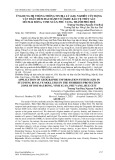
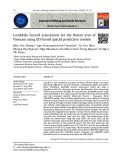
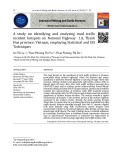

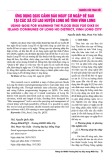
![Thiết kế thiết bị định vị nhóm GPS: Thu phát thông tin không dây [Chuẩn nhất]](https://cdn.tailieu.vn/images/document/thumbnail/2021/20210630/maoamin/135x160/7681625030696.jpg)
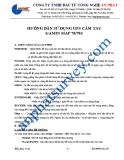




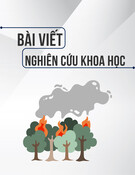

![Quy hoạch tổng thể Cà Mau: Tài liệu [mới nhất/chuẩn nhất]](https://cdn.tailieu.vn/images/document/thumbnail/2025/20250827/tghong1621@gmail.com/135x160/49401756278390.jpg)

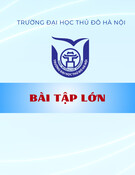
![Bài giảng Hàng hải địa văn [chuẩn nhất]](https://cdn.tailieu.vn/images/document/thumbnail/2025/20250729/vijiraiya/135x160/43361753782101.jpg)
![Bài giảng Trắc địa cơ sở [mới nhất]](https://cdn.tailieu.vn/images/document/thumbnail/2025/20250729/vijiraiya/135x160/84_bai-giang-trac-dia-co-so.jpg)





![Atlas tài nguyên nước Việt Nam: Tài liệu [Mô tả/Hướng dẫn/Chi tiết]](https://cdn.tailieu.vn/images/document/thumbnail/2025/20250715/vijiraiya/135x160/348_tai-lieu-atlas-tai-nguyen-nuoc-viet-nam.jpg)
![Hệ thống câu hỏi ôn tập Vùng kinh tế [chuẩn nhất]](https://cdn.tailieu.vn/images/document/thumbnail/2025/20250709/kimphuong1001/135x160/76921752140578.jpg)
